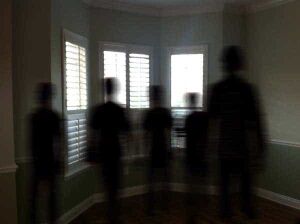Shadow people
Shadow people are a very common visual hallucination for humans to have. They usually appear as a result of sleep deprivation, psychosis (especially stimulant psychosis), delirium, psychoactive substances, or sleep paralysis, and can be considered a sub-type of autonomous entities. During this experience, the subject perceives a patch of shadow in their peripheral vision or focused visual field to be a living, autonomous figure. This figure can be either humanoid or animal-like in appearance.

The visual external hallucinations usually appear as initial fleeting images out of the corner of the eyes, in the peripheral vision. As the duration of the experience progresses. However, the hallucinations may appear in full view and one will be able to look directly at them, even being able to look away and look back at the entity without a change in the hallucination. This progression is typically the same whether one is experiencing shadow people from sleep deprivation or from stimulant psychosis.
The bodies of the shadow people are usually perceived as a type of blackness that has a sense of depth with few facial or bodily features. The blackness of the body often seems almost opaque as if one is looking into a "black hole" in anthropomorphic form. They sometimes appear to have faces and are able to move or change shape. It is also possible for multiple shadow people to occupy one's field of vision simultaneously while acting autonomously from one another.
This hallucinatory state is often accompanied with a feeling of intense paranoia and anxiety due to the fact that shadow people are subjectively sinister in appearance and usually a result of negative states such as psychosis and sleep paralysis. Shadow people appear often in sleep paralysis, often carrying with them a sense of impending doom during the experience[1]
Multisensory aspects
Although it is not an intrinsic part of this hallucinatory effect, shadow people can potentially be accompanied by other sensory components aside from one's visual perception of them. This is typically infrequent and usually only occurs during very intense states of sleep deprivation, delirium or psychosis. For example, shadow people can potentially have an accompanying "voice", despite the lack of a visible mouth structure. This auditory communication follows an identical leveling system of progressively more detailed and coherent spoken word in the same manner as a generic autonomous entity.
Alongside of accompanying auditory hallucinations, shadow people may also present tactile and gustatory hallucinations. This is even rarer than their potential auditory effects and typically only occurs in particularly intense and advanced hallucinatory states. Their tactile effects can be indistinguishable from a real human touch and generally varied in temperature.They can also even include physical actions such as pulling of clothing, hair, or the skin.
Image examples
History and culture
This History and culture section is a stub. As a result, it may contain incomplete or wrong information. You can help by expanding it. |
Shadow people have been referenced throughout poplar culture and time as 'demons', 'ghosts'[2], or even 'inter dimensional time travelers"[3]. This wide recognition of shadow people, their representation in common culture and horror films may contribute to the prevalence of these external hallucinations. From the common internet consensus on shadow people, they are more often thought of as ghosts or real inter dimensional beings than simple hallucinations.
The more an image is spread throughout culture, the more likely a person will manifest that image in a state such as sleep deprivation, delirium, and stimulant psychosis. The fear instilled by society and the negative connotation portrayed by society may influence the anxiety and feelings of unspeakable horrors when seeing these autonomous beings.
Psychoactive substances
Compounds within our psychoactive substance index which may cause this effect include:
Experience reports
Anecdotal reports which describe this effect within our experience index include:
- Experience:300mg DPH + 600mg DXM - An Interesting Combo
- Experience:4 Days Sleep Deprivation - Progression of Sleep Deprivation Visuals Over Time
- Experience:550mg-Bugs All Around Me.
- Experience:700mg Diphenhydramine trip
- Experience:Datura & DPH - Results of Experiment by Isopropanol
- Experience:Dem Shadow People and Such (A Retrospective)
- Experience:Sleep paralysis hallucinations
- Experience:Unknown dosage / 1 tab DOC - Psychedelia Turned Into Stimulant Psychosis
See also
References
- ↑ Shelley Adler (15 January 2011). Sleep Paralysis: Night-mares, Nocebos, and the Mind-Body Connection. Rutgers University Press. pp. 3–. ISBN 978-0-8135-5237-8.
- ↑ "Types of Shadow People" Blog http://www.angelsghosts.com/types_of_shadow_people_shadow_ghosts
- ↑ Nonscientific Shadow Person Blog http://www.shadowpeople.org/